Answered step by step
Verified Expert Solution
Question
1 Approved Answer
Q. I want Alternatively, Should NOKIA opt for internal fund by i. Lowering or eliminating dividend payout? ii. Utilising cash balance Nokia OrJ: Financing the
Q. I want Alternatively, Should NOKIA opt for internal fund by i. Lowering or eliminating dividend payout? ii. Utilising cash balance

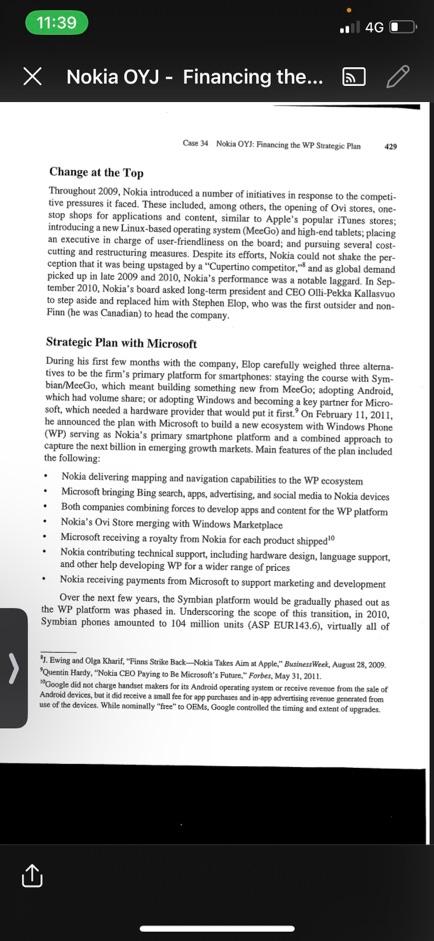
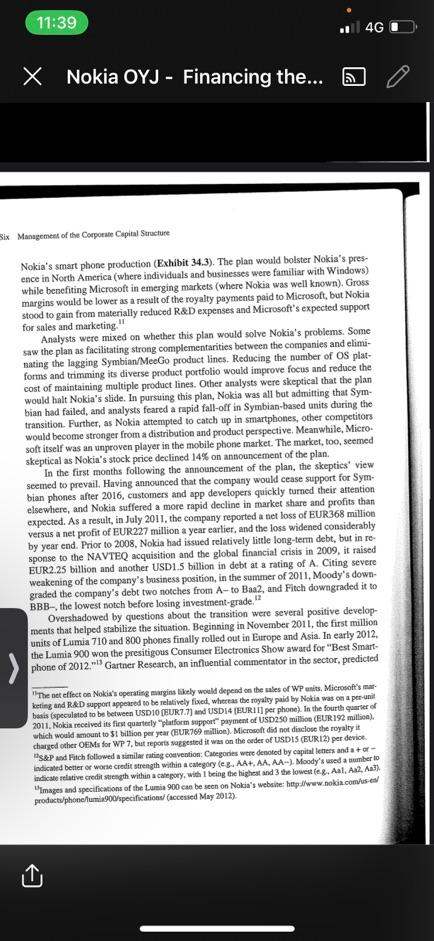
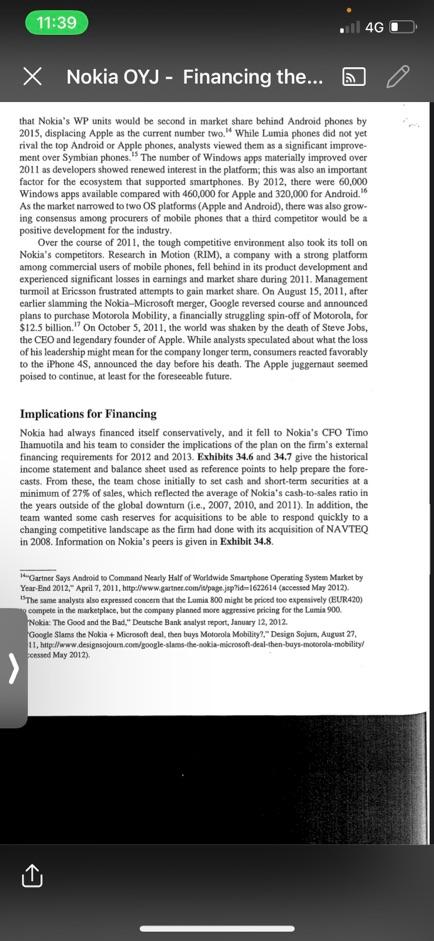

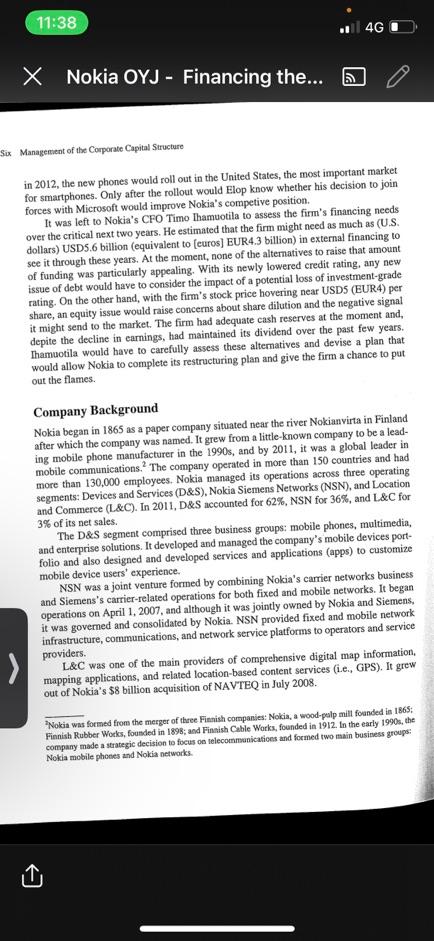
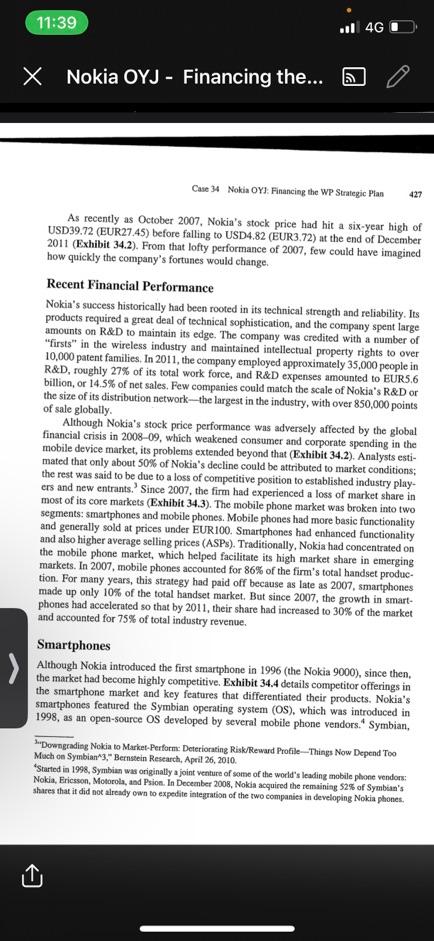
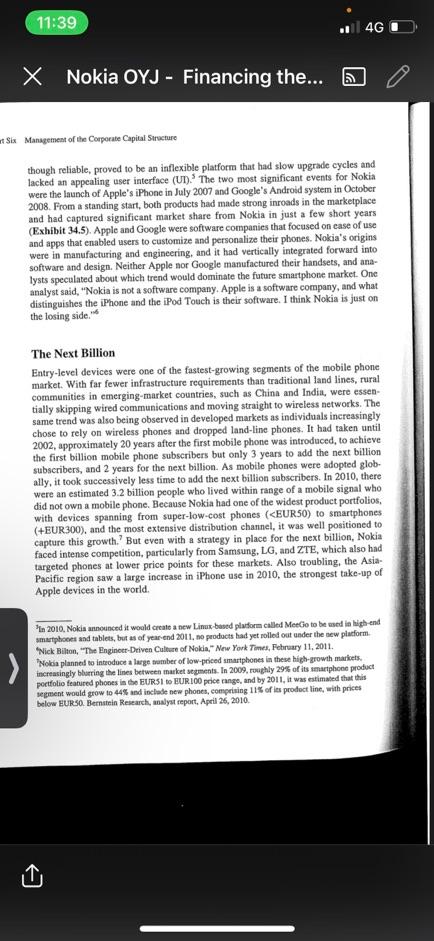
Nokia OrJ: Financing the Wrp strategic plan Thave learned we are saanding on a buming platjorm." - Stephen Elop, Nobla CEO In January 2012, Stephen Elop reflected on his turmultuous first year and a half as president asd CEO of Nokia. During that time, he had completed a review of the company's performance and strategic direction and been forced to admit to cmployees that they were "standing on a burning platform.," threatened by intense competition in the mobile phone market (Exhibit 34.1). In the preceding years, Nokia, the world's leading producer of mobile phones, had seen its market share and profits eroded by rival products such as Apple's iPhone and phones featuring Google's Android operating system. At the same time, its dominance in the larger, lower-priced phone segment had been threatesed by competition from Samsung, LG, and ZTE. In February 2011, Elop had made his first major decision to correct the company's course, a broad strategic plan and partnership with Microsoft ("the plan") in which, among other initiatives, Windows would serve as Nokia's primary smartphone platform. Rather than quell the coacerns as be had hoped, the plan's announcement bad seemed only to raise more questions about the scope and timing of the transition involved. Reinforcing those concems, the company had reported a net loss of earnings in July 2011 , which was followed by a downgrade of the company's credit rating the following month. In late 2011, the first Windows smartphones appeared in Europe and Asia (under the trade same Lumia), but the biggest challenge still awaited Nolkia. Beginning i "Full Tent Nokia CEO Stephen Ellop's "Thurning Pharform' Merno," Wall Street Journal, February 9, 2011, (accessed June 8, 2011). Thin case was prepured by Susan Chaplizdky, Protessor of Busisen Adninistrabion, Durdea School of Business, and Felici Marston, Profestor of Commeren, McIncire School of Conumerce. It was wrinen as a basis for elaas fiscuasion tather than to illettrate effective or ineffestive handling of as administrative sitaicion. Copyright 0 zolt ty the Univeraity of Virgiaia Dardes School Fuandatios, Charlohtewille, VA. All rightr ieserved Te ariler copies, send an en mail oo sales Oderdenbutinesspublahing coen. No part of this puObcation Darder 5 chool Fosondation. Change at the Top Throughout 2009 , Nokia introduced a number of initiatives in response to the competitive pressares it faced. These included, among others, the opening of Ovi stores, onestop shops for applications and content, similar to Apple's popular iTunes stores; introducing a new Linux-based operating system (MeeGo) and high-end tablets; placing an executive in charge of user-friendliness on the board; and pursuing several costeutting and restructuring measures. Despite its efforts, Nokia could not shake the perception that it was being upstaged by a "Cupertino competitor, "4 and as global demand picked up in late 2009 and 2010 , Nokia's performance was a notable laggard. In September 2010, Nokia's board asked long-term president and CEO Olli-Pekka Kallasvuo to step aside and replaced him with Stephen Elop, who was the first outsider and nonFin (he was Canadian) to head the company. Strategic Plan with Microsoft During his first few months with the company, Elop carefully weighed three alternatives to be the firm's primary platform for smartphones: staying the course with Symbian/MeeGo, which meant building something new from MeeGo; adopting Android, which had volume share; or adopting Windows and becoming a key partner for Microsoft, which needed a hardware provider that would put it first. 7 On February 11, 2011, he announced the plan with Microsoft to build a new ecosystem with Windows Phone (WP) serving as Nokia's primary smartphone platform and a combined approach to capture the next billion in emerging growth markets. Main features of the plan included the following: - Nokia delivering mapping and navigation capabilities to the WP ecosystem - Microsoft bringing Bing search, apps, advertising, and social media to Nokia devices - Both companies combining forces to develop apps and conteat for the WP platform - Nokia's Ovi Store merging with Windows Marketplace - Microsoft receiving a royalty from Nokia for each product shipped 10 - Nokia contributing technical support, including hardware design, language support, and other help developing WP for a wider range of prices - Nokia receiving payments from Microsoft to support marketing and development Over the next few years, the Symbian platform would be gradually phased out as the WP platform was phased in. Underscoring the scope of this transition, in 2010, Symbian phones amounted to 104 million units (ASP EURI43.6), virtually all of 'Quentin Hurdy, "Nokia CeO Paying to Be Microsof's Fubuer," Farber, May 31, 2011. "Goople did not charge handivet makers for its Android openating syatem or receive revenve from the sale of Anderid devices, ber it did receive a imall fee for app parchases und in-upp advertising reverwe genersaed from use of the devices. While nominally "fire" s OEMs, Google controlled the timing ind extent of upgrades. Management of the Corpotaie Capilal strucure Nokia's smart phone production (Exhibit 34.3). The plan would bolster Nokia's presence in North America (where individuals and businesses were familiar with Windows) while benefiting Microsoft in emerging markets (where Nokia was well known). Gross margins would be lower as a result of the royalty payments paid to Microsoft, but Nokia stood to gain from materially reduced R.D expenses and Microsoft's expected support for sales and marketing. Analysts were mixed on whether this plan would solve Nokia's problems. Some saw the plan as facilitating strong complementarities between the companies and eliminating the lagging Symbian/MecGo product lines. Reducing the number of OS platforms and trimming its diverse product portfolio would improve focus and reduce the cost of maintaining multiple product lines. Other analysts were skeptical that the plan would halt Nokia's slide. In pursuing this plan, Nokia was all but admitting that Symbian had failed, and analysts feared a rapid fall-off in Symbian-based units during the transition. Further, as Nokia attempted to catch up in smartphones, other compctitors. would become stronger from a distribution and product perspective. Meanwhale, Microsoft itself was an unproven player in the mobile phone market. The market, too, seemed skeptical as Nokia's stock price declined 14% on ansouncement of the plan. In the first months following the announcement of the plan, the skeptics' view seemed to prevatl. Having announced that the company would cease support for Symbian phones after 2016, customers and app developers quickly turned their aftention elsewhere, and Nokia suffered a more rapid decline in market share and profits than expected. As a result, in July 2011 , the company reported a net loss of EUR368 million versus a net profit of EUR227 million a year earlier, and the loss widened considerably by year end. Prior to 2008. Nokia had issued relatively lizkle long-term debt, but in response to the NAVTEQ acquisition and the global financial crisis in 2009 , it raised EUR2.25 billion and another USD1.5 billion in debt at a rating of A. Citing severe weakening of the company's business position, in the summer of 2011, Moody's downgraded the company's debt two notches from A to Baa2, and Fitch downgraded it to Overshadowed by questions about the transition were several positive developmeats that helped stabilize the situation. Beginning in November 2011 , the first million units of Lumia 710 and 800 phones finally rolled out in Europe and Asia. In early 2012. the Lamin 900 won the presitigous Consumer Electronics Show award for "Best Smartphone of 2012," Gartner Research, an influential commentator in the sector, predicted The net effect on Nokia'ir operating angins likely would depend on the ules of WP anits. Micropaft's marr. keting and RKD suppori appeared so be rehatively fixed, whereas the royalty paid by Nokin was on a per-unil basis (speculated to be between USD10 [BUR7.7] and USDI4 [EUR11] per phone). in the fourth qaarker of: 2011. Nokia received its first quarterly "platform suppott" payment of USDZS0 millios (EUR192 milliea). which would amount to \$1 bilion per year (BURT69 ritlioe). Microoft did not diaclose the royalty it chargod other OEMs for WP 7, but aeports saegested ir was on the euder of USDI5 (EUR12) per device. DseP and Fatch followed a similar eating coavention: Categones were denoted by capital lethers and a + or indicaled better or worse credit strength within a calegory (e- E- AA+, AA, AA-). Moody's ased a number to ladicale stelative credit steength within a category, with 1 being the highest and 3 the lowest (E \&, Aat, Aa2, Aas). Himages and specifications of the Luraia 900 can be seen on Nokia's webaite: hatpollwww.nokia com/us-es' productiphonellumia900/specifications/ (accesied May 2012). that Nokia's WP units would be seeond in market share behind Android phones by 2015 , displacing Apple as the current number two. 14 While Lumia phones did not yet rival the top Android or Apple phones, analysts viewed them as a significant improvement over Symbian phones." The number of Windows apps materially improved over 2011 as developers showed renewed interest in the platform; this was also an important factor for the ecosystem that supported smartphones. By 2012, there were 60,000 Windows apps available compared with 460,000 for Apple and 320,000 for Android. 16 As the market narrowed to two OS platforms (Apple and Android), there was also growing consensus among procurers of mobile phones that a third competitor would be a positive development for the industry. Over the course of 2011 , the tough competitive environment also took its toll on Nokia's competitors. Research in Motion (RIM), a company with a strong platform among commercial users of mobile phones, fell behind in its product development and experienced significant losses in earnings and market share during 2011. Management turmoil at Ericsson frustrated attempts to gain market share, Ox August 15, 2011, after earlier slamming the Nokia-Microsoft merger, Google reversed course and announced pians to purchase Motorola Mobility, a financially struggling spin-off of Motoroln, for $12.5 billion. 17 On October 5, 2011, the world was shaken by the death of Steve Jobs, the CEO and legendary founder of Apple. While analysts speculated about what the loss of his leadership might mean for the company longer term, consumers reacted favorably to the IPhone 4S, announced the day before his death. The Apple juggemaut seemed poised to continue, at least for the foreseeable future. Implications for Financing Nokia had always financed itself conservatively, and it fell to Nokin's CFO Timo Thamuotila and his team to consider the implications of the plan on the firm's external financing requirements for 2012 and 2013. Exhibits 34.6 and 34.7 give the historical income statement and balance sheet used as refereace points to help prepare the forecasts. From these, the team chose initially to set cash and short-term securities at a minimum of 27% of sales, which reflected the average of Nokia's cash-to-sales ratio in the years outside of the global downturn (i.e., 2007, 2010, and 2011). In addition, the team wanted some cash reserves for acquisitions to be able to respond quickly to a changing competitive landscape as the firm bad done with its acquisition of NAVTEQ in 2008. Information on Nokia's peers is given in Exhibit 34.8. 14.Gartner Says Android to Command Nearty Half of Worldwide Smartphone Operaring Sywem Murket by Year End 2012," Apri1 7, 2011, hitpollwww. gatnet.comilepage.jap7id-1622614 (accessed May 2012). "The same analystr also expressed concern that the Lamia 800 might be pricod toe expeatively (EUR420) The compete in the marketplace, tot the company planned more agzessive pricing for the Lumta 900 . Nokis. The Good and the Bad, " Deutcche Bank asalyst report, Januiry 12, 2012. Google Slans the Nokia + Microsof deal, then buys Motorola Mobility2," Design Sojurn, Augeat 27, cessed May 2012), Management of the Corporate Capital structure Nokia, like other technology companies, typically chose to maintain high cash balances to bolster perceptions of its financial strength. Bill Wetreich, a managing director at S\&P, explained: Tech companies tend to self-impose high cash balances on themselves for a couple reasons. For one, a lot of cash is tied up in the business because they tend to self-fund working capital, R\&D, etc., and don't make much use of commercial paper. Another reason is that they can miss a product cycle and need cash to see them through. Yoa don't have to look very far to see examples of tech companies that miss a product cycle and have their financial strength mpidly disappear," Academics routinely prescribed more debe for these companies to take advantage of the tax savings on interest to lower the furm's cost of eapital and to control agency costs by reducing the free cash flow at managers" discretion. The financial press simply called for higher dividends or share repurchases. In the meantime, companies appeared to reject those arguments and increased cash holdings, from an average cash-to-assets ratio of 10.5% in 1980 to 23.5% in 2006.$ The secular increase in cash holdings seemed to saggest firms were responding to increased risk and using cash as some kind of buffer, Given the uncertainty regarding Nokia's future market share, Ihamuotila forecasted a range of possible outcomes. Exhibit 34.9 gives a forecast of Nokia's income statement by segment for 2012 and 2013 for one representative upside and downside scenario. He believed the downside scenario should be given greater weight for planning purposes given the firm's recent financial performance and the difficult transition ahead. For Devices and Services (D\&S), the largest division, the downside scenario recognized the continued significant loss of Symbian and overall Nokia market share, while under the upside scenario, sales stabilized and were predicted to exceed 2011 levels by 2013. Gross margins were expected to decline due to competitive price pressure, royalty payments to Microsoft, and aggressive pricing of Nokia phones, reflecting Elop's strategy for capturing market share. Under the downside scenario, these factors were expected to erode gross margins to 24% in the near term, while under the upside scenario, gross margins were projected at 26% over the next two years, Lower margins lead to lower adjusted operating profits in the pro formas, but these were partially offset by savings from restructuring efforts and Microsoft's support for R\&D and marketing functions, with the upside scenario reflecting more and faster realization of savings. Nokia Siemens Networks (NSN) annoanced a major restructuring effort in late 2011 , which woald resalt in significant near-term restructuring charges and a phase-out of less-profitable operations. Profits had been slow to materialize at NSN, and the downside scenario reflected continuing struggles for this division. Location and Commerce (L. \&C) had also been a disappointing performer (resulting in a significant writedown of goodwill in 2011), and the forecasts pointed to continued subpar performance. tCCasewriserinterviewwithBillWeteich,May24,2011. 13Themas W. Bates, Kathleen M. Kahle, and Rent M. Stulz, "Why Do Furms Hold So Moch More Cash Than They Uted To7," Journal of Finance 64, no. 5(2009)c19452002. ix Management of the Corporate Capital Structure in 2012, the new phones would roll out in the United States, the most important market for smartphones. Only after the rollout would Elop know whether his decision to join forces with Microsoft would improve Nokia's competive position. It was left to Nokia's CFO Timo lhamuotila to assess the firm's financing needs over the critical next two years. He estimated that the firm might need as much as (U.S. dollars) USD5.6 billion (equivalent to [euros] BUR4.3 billion) in external financing to see it through these years. At the moment, none of the altermatives to raise that amount of funding was particularly appealing. With its newly lowered credit rating, any new issue of debt would have to consider the impact of a potential loss of investment-grade rating. On the other band, with the firm's stock price hovering near USD5 (EUR4) per share, an equity issue would raise concerns about share dilution and the negative signal it might send to the market. The firm had adequate cash reserves at the moment and, depite the decline in earnings, had maintained its dividend over the past few years. Thamuotila would have to carefully assess these alternatives and devise a plan that would allow Nokia to complete its restructuring plan and give the firm a chance to put out the flames. Company Background Nokia began in 1865 as a paper company situated near the river Nokianvirta in Finland after which the company was named. It grew from a little-known company to be a leading mobile phone manufacturer in the 1990 s, and by 2011 , it was a global leader in mobile communications. 2 The company operated in more than 150 countries and had more than 130,000 employees. Nokia managed its operations across three operating segments: Devices and Services (D\&S), Nokia Siemens Networks (NSN), and Location and Commerce (L\&C). In 2011, D\&S accounted for 62\%, NSN for 36\%, and LeC for 3% of its net sales. The D\&S segment comprised three business groups: mobile phones, multimedia, and enterprise solutions. It developed and managed the company's mobile devices portfolio and also designed and developed services and applications (apps) to customize mobile device users' experience. NSN was a joint venture formed by combining Nokia's carrier networks business and Siemens's carrier-related operations for both fixed and mobile networks. It began operations on April 1, 2007, and although it was jointly owned by Nokia and Siemens, it was governed and consolidated by Nokia. NSN provided fixed and mobile network infrastructure, communications, and network service platforms to operators and service providers. L\&C was one of the main providers of comprehensive digital map information, mapping applications, and related location-based content services (i.e., GPS). It grew out of Nokia's $8 billion acquisition of NAVTEQ in July 2008. "Nokia was Sormed from the merget of three Finnish companies: Nokia, a wood-palp mill foanded in 1865: Finnish Rubber Works, fousded in 1898; and Finaish Cable Works, founded in 1912. In the early 1990s, the company made a strategic decision to focus on telecommanicatices and formed two main business grougs: Nokia mobile phoees and Nokia networks. As recently as October 2007, Nokia's stock price had hit a six-year high of USD39.72 (EUR27.45) before falling to USD4.82 (EUR3.72) at the end of December 2011 (Exhibit 34.2). From that lofty performance of 2007, few could have imagined how quickly the company's fortunes would change. Recent Financial Performance Nokin's success historically had been rooted in its technical strength and reliability. Its products required a great deal of technical sophistication, and the company spent large amounts on R\&D to maintain its edge. The company was credited with a number of "firsts" in the wireless industry and maintained intellectual property rights to over 10,000 patent families. In 2011, the company employed approximately 35,000 people in R&D, roughly 27% of its total work force, and R\&D expenses amounted to EURS.6 billion, or 14.5% of net sales. Few companies could match the scale of Nokia's R\&D or the size of its distribution network - the largest in the industry, with over 850,000 points of sale globally. Although Nokia's stock price performance was adversely affected by the global financial crisis in 2008-09, which weakened consumer and corporate spending in the mobile device market, its problems extended beyond that (Exhibit 34.2). Analysts estimated that only about 50% of Nokia's decline could be attributed to market conditions; the rest was said to be due to a loss of competitive position to established industry players and new entrants. 3 Since 2007, the firm had experienced a loss of market share in most of its core markets (Exhibit 34.3). The mobile phone market was broken into two segments: smartphones and mobile phones. Mobile phones had more basic functionality and generally sold at prices under EUR100. Smartphones had enhanced functionality and also higher average selling prices (ASPs). Traditionally, Nokia had concentrated on the mobile phone market, which helped facilitate its high market share in emerging markets. In 2007, mobile phones accounted for 86% of the firm's total handset production. For many years, this strategy had paid off because as late as 2007 , smartphones made up only 10% of the total handset market. But since 2007 , the growth in smartphones had accelerated so that by 2011 , their share had increased to 30% of the market and accounted for 75% of total industry revenue. Smartphones Although Nokia introduced the first smartphone in 1996 (the Nokia 9000), since then, the market had become highly competitive. Exhibit 34.4 details competitor offerings in the smartphone market and key features that differentiated their products. Nokia's smartphones featured the Symbian operating system (OS), which was introduced in 1998 , as an open-source OS developed by several mobile phone vendors. 4 Symbian, "Downgradiag Nokia to Market-Perform: Deteriorating Risk/Reward Profile - Things Now Depend Too Mach on Symbian ," " Bernstein Research, April 26, 2010. 'Started in 1998, Symbian was originally a joint venture of some of the world's leading mobile phone vendons: Nokia, Ericsson, Motorols, and Psion. In Deceenber 2008, Nokia acquired the remaining 52% of Symbian's shares that it did not already own to expectite integration of the two companies in developing Nokia phones. Management of the Corporate Capital Structure though reliable, proved to be an inflexible platform that had slow upgrade cycles and lacked an appealing user interface (UT). The two most significant events for Nokia were the launch of Apple's iPhone in July 2007 and Google's Androd system in October 2008. From a standing start, both products had made strong inroads in the marketplace and had captured significant market share from Nokia in just a few short years (Exhibit 34.5). Apple and Google were software companies that focused on case of use and apps that enabled users to customize and personalize their phones. Nokia's origins were in manufacturing and engineering, and it had vertically integrated forward into software and design. Neither Apple nor Google manufactured their handsets, and analysts speculated about which trend would dominate the future smastphone market. One analyst said, "Nokia is not a software company. Apple is a software company, and what distinguishes the iPhone and the IPod Touch is their software. I think Nokia is just on the losing side, n The Next Billion Entry-level devices were one of the fastest-growing segments of the mobile phone market. With far fewer infrastructure requirements than traditional land lines, rural commanities in emerging-market countries, such as China and India, were essentially skipping wired communications and moving straight to wireless networks. The same trend was also being observed in developed markets as individuals increasingly chose to rely on wireless phones and dropped land-line phones. It had taken until 2002 , approximately 20 years after the first mobile phone was introduced, to achieve the first billion mobile phone subscribers but only 3 years to add the next billion subscribers, and 2 years for the next billion. As mobile phones were adopted globally, it took successively less time to add the next billion subscribers. In 2010 , there were an estimated 3.2 billion people who lived within range of a mobile signal who did not own a mobile phone. Because Nokia had one of the widest product portfolios, with devices spanning from super-low-cost phones ( EUR50) to smartphones (+ EUR 300), and the most extensive distribution channel, it was well positioned to capture this growth. 7 But even with a strategy in place for the next billion, Nokia faced intense competition, particularly from Samsung, LG, and ZTE, which also had targeted phones at lower price points for these markets. Also troubling, the AsiaPacific region saw a large increase in iPhone use in 2010, the strongest take-up of Apple devices in the world. 'In 2010. Nokia announced it would create a new Linux-bused platorn called MeeGo to be ased ia high - end smartphooes sad tablets, but as of yearend 2011, no peoducts had yet nolled out under the new placform. "Nick Bilton, "The Enginoer-Driven Culture of Nolda," New York Tames, Febrary 11, 2011. TNolia planneil to introduce a large tamber of low-priced smartphones in these high-growth markets. increasingly bburring the lines between market segments. In 2009 , roughly 29% of its smartphone product pertfolio feanured phooes in the BURSI to BUR 100 price cange, and by 2011, it was estimated that tais segment would grow to 44% and inclade new phones, comprixing 11% of ies prodoct line, with prices below BURS0. Bernstein Research, analyst report, April 26,2010
Step by Step Solution
There are 3 Steps involved in it
Step: 1

Get Instant Access to Expert-Tailored Solutions
See step-by-step solutions with expert insights and AI powered tools for academic success
Step: 2

Step: 3

Ace Your Homework with AI
Get the answers you need in no time with our AI-driven, step-by-step assistance
Get Started


